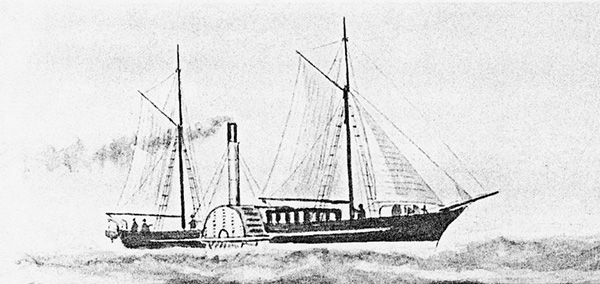Jade River: A History of the Mahurangi
Ronald H LockerFirst published 2001. Published online 2014–. This online edition is a work in progress…
Pages 155–157in printed edition
Steam comes to the Mahurangi

Want of a Wonga Wonga: For the want of a verifiable image of the paddle steamer Wonga Wonga, the second steam-engined vessel to—briefly—service the Mahurangi, the paddle steamer Emu, is shown here. She then commenced a regular but short-lived ferry service between Devonport and the city—while hired by entrepreneur Robert Graham of Waiwera fame to take a parliamentary-term-end party consisting of most of New Zealand’s MPs to his Motutapu home, she was wrecked on what since has been known as Emu Rock. No lives, parliamentary or otherwise, were lost. image Alexander Turnbull Library
Henry Pulham in 1889 recalled the beginnings of steamboat service to the Mahurangi. He said:
The cutter Francis—was the only means of getting to town, although for some weeks in 1855 the steamer Wonga Wonga ran here. Some settlers were persuaded to take shares, but—the little trade was not sufficient to support so large a vessel, and we lost our money and the steamer too, and we had to fall back on the cutters. Heather Bell had taken up the running in place of Francis. Our next attempt at steam was in 1860 when a little steamer called Emu paid us a few visits, then in 1868 Enterprise No.2 came a few times, but gold being discovered at the Thames, she was abruptly taken away for the trade and we were again left to the care of Captain Dam and Heather Bell. It was not until the year 1871 that steam communication was firmly established between here and Auckland when Captain Casey, who deserves to have his name immortalised, came with the steamer Lady Bowen and kept her running for a long time without paying her expenses, but ultimately trade increased.
These first three steamboats deserve some comment.
The steamboat Wonga Wonga had just arrived in Melbourne from Greenock under sail in 1854, when she was purchased by the Local Steam Navigation Company of Auckland. Daldy was a director. She arrived in Auckland under sail with burned out boilers. She was 108 tons, 106 feet long, rigged as a brig, and had two 30 horsepower low-pressure engines driving screws. On 13 March 1855, she made her first run north: to Mahurangi, Kawau, Whangārei, Bay of Islands (and later to Mangonui). Voyages were made about fortnightly, with runs to Mahurangi and Kawau interspersed. Passengers for Mahurangi were dropped at Scotts Landing. The fare was 12 shillings cabin, 10 shillings steerage, and was high for the time. Combes and Daldy were the agents. Although the vessel performed well, costs proved high. A further boiler burnout did not help. The share capital was never fully paid up, and a loan had to be raised. A subsidy from the provincial government briefly postponed insolvency, but when it was cut, the steamboat was laid up in April 1857. Later that year it was sold to the Wellington Steam Navigation Company (ancestor of the Union Steamship Company). The ship then had a varied life, serving ports in the lower North Island and upper South Island. It served the Commissariat in the Taranaki Wars, took prospectors to the new Otago diggings, and was first to enter the Whanganui and Manawatu Rivers. In 1863 it had the distinction of picking up most of the survivors from hms Orpheus. It happened to be going out over the Manakau bar, bound south, just after the Orpheus struck. In 1864, the Wonga Wonga was back briefly on its former service to Mahurangi and up the east coast of Northland. (This ship should not be confused with a much larger contemporary steamer of the same name, also belonging to Wellington Steam Navigation Company, which served on the Wellington to Melbourne run from 1858, and later to San Francisco).
The other two ships were the first Auckland ferries. The steam wheeler Emu arrived on the Waitematā from Melbourne via Nelson, and in May 1860 established under government contract the first scheduled service to the North Shore, twice daily to Northcote at a shilling each way. The service was short-lived. The Emu struck rocks off Motutapu on 27 October, while returning from a Hauraki Gulf excursion. Captain Kreeft lost all but the engines. The spot is known as Emu Bay. North Shore folk then had to put up with whaleboats until 1865, when the paddle steamer Waitematā went into service for the Waitematā Steam Ferry Service. It soon had a competitor in the Enterprise of Holmes Brothers, who, before long, bought out the Waitematā and renamed her Enterprise No.2. As with the Wonga Wonga, Pulham’s memory of this ship was faulty. Her service to the Mahurangi Harbour was a little earlier and more prolonged than Pulham remembered:
A meeting of the settlers was held at Southgate’s Hotel relative to supporting the steamer Enterprise No.2, now running to this port. The general opinion was that if the owners continue to run her in this trade, she will eventually pay—so far the undertaking had succeeded beyond expectation. Auckland Weekly News 9 March 1867
Unfortunately for the settlers, the Thames gold rush began in August, and her owners found a much more lucrative run. They used her in the Thames trade for many years. She worked as late as 1898 under the Northern Company flag.
